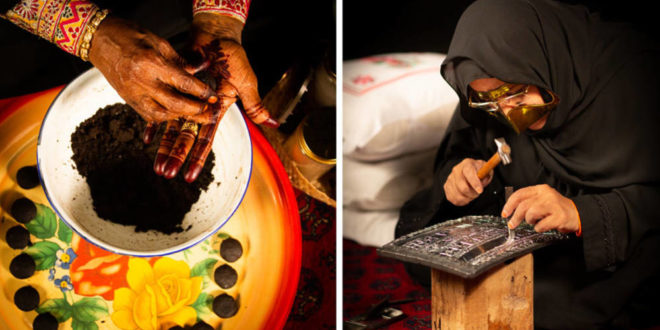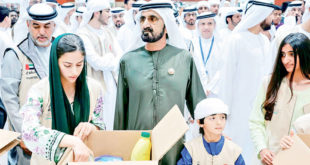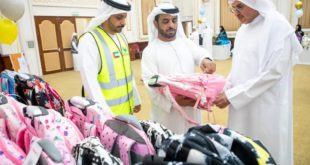The inhabitants of the mountainous regions excelled in making pottery and building houses
Traditional occupations vary between the environments of the sea, desert, mountains and oases
Coastal residents excelled in building large ships and wooden boats
Heritage has an unmissable presence in the diaries of the UAE, and its vocabulary has a special place in the heart and mind of every Emirati. Preserving the system of authentic values and national identity was the cornerstone of the nation-building strategy, embodying the saying of the late Sheikh Zayed bin Sultan Al Nahyan, may God bless his soul: «From He has no past, no present, and no future.
The slogan “Our Heritage”, carried by the third edition of the “The Most Beautiful Winter in the World” campaign, translates the story of loyalty to the traditions and values of parents and grandparents, and immortalizes the lifestyles that grandparents lived since ancient times as they sought the paths of livelihood, and it has become an integral part of our national identity.
Traditional heritage crafts and professions are of great interest in the UAE, and preserving them and introducing new generations to them has become a solid institutional work, the pillar of which is long-term planning, preparing qualified national competencies and providing them with everything necessary to keep these professions alive, and promote them on a large scale. Because of the great value it represents in the culture and memory of the people of the Emirates.
The list of Emirati traditional and historical crafts is long, as it includes multiple types that vary between the environments of the sea, desert, mountains and oases, and all of them formed a rich cultural human painting, the most prominent of which are the art of adapting to the place and climatic conditions, overcoming difficulties, and adhering to the national identity, ancient history and human civilization of a people who knew the dignity of living. Building on the glories of the ancients to build a beautiful present and look forward to a promising future.
Homeland memory
Dozens of traditional crafts are still alive in Emirati society, and capture the spotlight in festivals and national events that attract skilled practitioners in making swords and daggers, talli, ropes, stripping wickerwork, spinning wool, loaning burqas, carpentry, making yazra, garaqir, safafa, ships, perfumes, Sadu, dukhoon, sweets, traditional dishes, and many more.
Skilled craftsmen in the cities of the Emirates made swords, daggers, and copper household tools, and the inhabitants of the mountainous regions were creative in making pottery, building fortified stone houses, and digging wells and ponds.
Inherited authenticity
The “salty” industry has spread on the coasts of the Emirates, especially in the eastern region, and it is a traditional method that was active in the summer to preserve fish for as long as possible, and these products are still very popular, to this day.
Coastal residents excelled in building large ships such as the “owl”, small wooden boats and fishing tools, such as the “gargoor”, which is one of the oldest fishing tools in the Emirates, and was made from palm fronds before the later trend towards using metal wires. “Al-Lekh” of cotton or nylon threads.
Palm land
The people of the Emirates have a special relationship with the palm tree, and they have excelled in benefiting from all that it provides, such as fruits, trunks, fibers, leaves and fronds. They made poles from the trunks for tents and for building old houses, and from the branches they made beds for sleeping, seats, and cages for birds.
In areas where palm trees abound, the profession of “al-Saffa” has spread, and it is one of the handicrafts that Emirati women practiced in the past, which is weaving palm trees.
Search for water
The residents of agricultural areas in the Emirates were famous for their ingenuity in professions and industries related to obtaining water and irrigation tools, the most important of which is the “yazra”, which is a wooden list from which ropes hang to the water well with a bucket or two buckets, and after the water collects in it, the bulls drag it to the surface of the well, and from Then the water is emptied into pre-prepared channels to make its way to irrigate the crops.
Residents of agricultural areas were also interested in making molasses from dates, to be used in the production of sweets and popular foods.
I am gold
The “Sadu” craft is of great importance in the heritage of the UAE, and the country was able to include it in 2011 in the “UNESCO” list of the intangible cultural heritage of humanity that needs urgent preservation.
In the past, women excelled, especially in the desert, in the craft of “Sadu” and wool spinning, and their golden fingers created exquisite shapes that adorned the houses of poetry, and these creations are still present despite the spread of counterfeit products. Sadu is one of the traditional Bedouin textiles, and camel hair, or goat hair and sheep’s wool are often used to weave it.
Al-Tali is considered one of the famous traditional crafts, and one of the most ancient arts of embroidery in the UAE. It consists of silk threads and metal wicker, and is woven on a tool called “kajuja”, which is a pillow on an iron base on which the threads are fixed.
The “Tali” craft, which was included in the UNESCO list of intangible cultural heritage last November, was still used to decorate Emirati women’s clothing, and it was made using threads of silver and gold, but today flat metal threads are used in it, and pieces of ” Al-Tali is used for various things other than clothes.
 Media ININ Economy We Trust
Media ININ Economy We Trust








